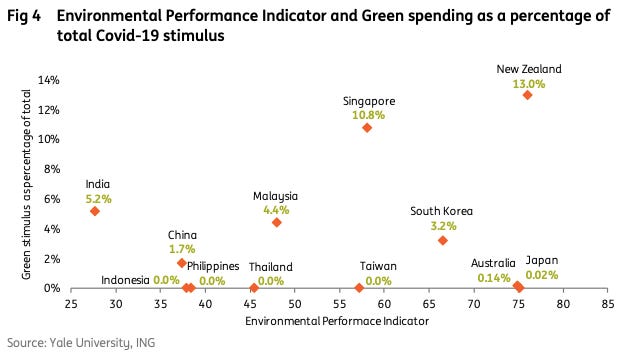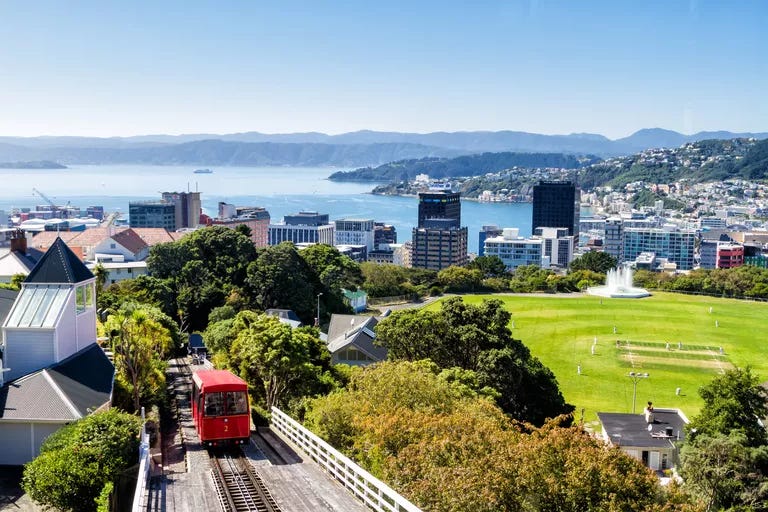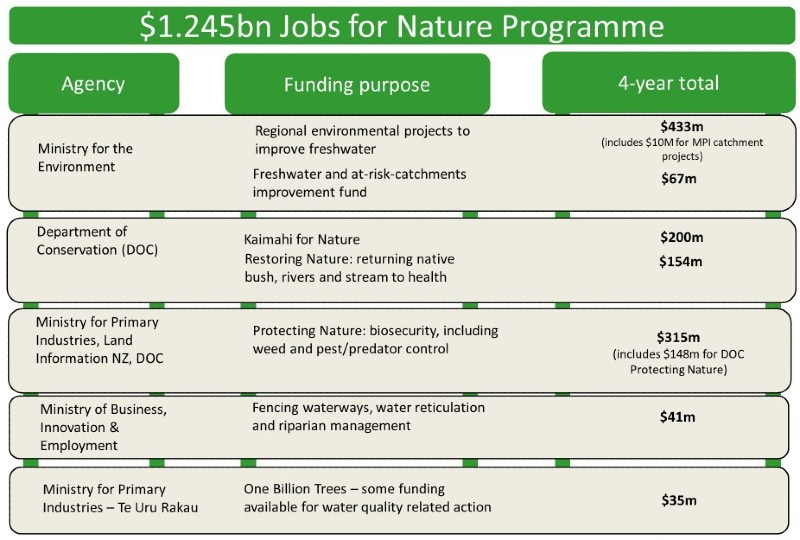Issue #4 How's your green recovery doing?
A quick look at three Asia-Pacific countries' green response to COVID-19
👋🏻 Bonjour everybody, welcome to Issue#4 where we will discuss some key features of Asia-Pacific’s green recovery plans.
As usual, if you like the newsletter, feel free to share it with your friends and colleagues 🙏🏻 Stay also tuned for two new podcast episodes that I will share soon!
Worldwide, many countries have passed stimulus packages to address the compounding risks of COVID-19 and climate change, promoting “Build Back Better” initiatives.
🌱 The European Union has passed the European Green Deal and strives to be the first climate-neutral continent in 2050. In the US, the new Biden administration has dedicated around US$2 trillion to invest in clean energy, infrastructure and mobility and is preparing to deal with climate change in a way no US president has done before. China has unveiled a US$1.4 trillion “New Infrastructure” plan to speed up its industrial revolution and support its sustainability efforts. The extension of inter-city high-speed connections is one of the major highlights of the Chinese plan.
🌏 Where is Asia-Pacific standing in the current rush towards greening economies? Many commentators have lamented over the fact that the region is not reaching enough for the environment reset button, as argued in this report from ING (from which the graph below is extracted).
Yet, there are interesting policy innovations that are worth mentioning and I invite you to quickly dive into three green recovery plans in Asia-Pacific : 🇸🇬 Singapore, 🇰🇷 South Korea and 🇳🇿 New Zealand.
🇸🇬 Singapore: Whole-of-Nation Efforts to Fight Climate Change
On February 10th 2021, Singapore publicly announced its Green Plan 2030, an ambitious “whole-of-nation” effort to accelerate the city-state’s sustainability agenda.
Key targets of Singapore’s Green Plan include:
Planting 1 million more trees
Quadrupling solar energy deployment by 2025
Reducing the waste sent to landfill by 30% by 2030
At least 20% of schools to be carbon neutral by 2030
All newly registered cars to be cleaner-energy models from 2030
🌱 Singapore’s Green Plan 2030 offers interesting insights to prepare for a green future, for two main reasons:
🏙 It is a city-scale green recovery plan and thus gives a vision of how cities could adapt to a climate-resilient future.
Singapore is a city-state and is able to orient its energy, mobility, water and food policies. It’s a unique situation in the sense that other cities might not have the same capacity to fully govern and influence their energy, food or water supply chains, leaving less room for manoeuvre.
🌊 It has a clear emphasis on climate change, particularly sea-level rise, and translates new planning concepts into policies.
As one of the greenest cities in the world, Singapore can leverage its green (and blue) assets to foreground new planning responses to climate change and environmental crises, such as the City in Nature approach where biodiversity flourishes side by side with humans, thanks to world-class nature parks and interconnected urban gardens.
🇰🇷 South Korea: a Digital and Green Society New Deal
South Korea is one of the biggest polluters per capita in Asia-Pacific.
The Korean New Deal, announced in July 2020, plans to invest US$135 billion on two main schemes – the Digital New Deal and the Green New Deal- together with an overarching policy support to strengthen employment and social safety net.
📱 The Green New Deal means investing in advanced technology initiatives to create jobs and includes (as summarised in this great article):
An expansion of solar panels and wind turbines to 42.7 gigawatts by 2025
An acceleration of smart grids and plans to install smart meters in 5 million more apartments, to help consumers reduce their electricity use
Investments in “microgrid communities”, using renewable energy and energy storage systems in regional areas, to create decentralised, low-carbon energy systems
A target of 1.13 million electric vehicles and 200,000 hydrogen-powered fuel-cell electric vehicles on Korean roads by 2025
Circular economy initiatives such as reducing and recycling energy, using advanced computerised power grids in factories
The “K-New Deal” is ambitious and unique and while it seems to be more “grey” than green, there are interesting features to bear in mind:
🧩 Digital and Green are going hand in hand
South Korea envisions strong synergies between industrial and technological innovations in the digital and green sectors. Not surprising for such a tech-savvy country. The green remodeling of the economy can only be enabled by digital innovation, as seen in the key 10 projects, such as Digital Twins, New Mobility Systems, AI Government and so on.
👨💻 The creation of a “Data Dam” to build up the foundations of the future economy
The K-New Deal responds to global data usability challenges by creating a “data dam” infrastructure to collect data from public and private sources and then standardize it so it can be analyzed. How much this ambitious initiative will support the greening of the economy remains to be seen but South Korea, more than ever, bets on high-tech to solve its environmental and social challenges.
🇳🇿 New Zealand: Jobs for Nature and Increased Government Transparency
Jacinda Ardern’s government inaugurated in 2017 a phase of rapid climate-related policy development, drawing especially from UK and EU examples.
As described in this very good article , New Zealand has become a “fast follower” in terms of climate action, meaning that the country is turning towards the right direction without necessarily being a pioneer in climate leadership.
🌳 In the context of COVID-19 recovery, a crisis where New Zealand has been lauded as a role model, the country’s green plans include (but are not limited to):
the One Billion Trees Program
the pledge to transition to 100% renewable electricity by 2030
a green hydrogen strategy that includes a nationwide hydrogen refuelling network
the completion of the first national climate change risk assessment
budget boosts for rail and sustainable land use
a regional fuel tax in Auckland to fund public transport
NZ$1.1 billion for nature-based jobs (see details below)
the reincorporation of climate mitigation into resource consenting processes for local government
the adoption of the Task Force on Climate-related Financial Disclosures (TCFD) framework for mandatory reporting of climate-related risks
(Sourced from the same very comprehensive article!)
Again, I am highlighting two interesting components of New Zealand’s green recovery strategy:
🧑🌾 Jobs for Nature: a first step towards a nature-based economy?
The country aims to create up to 11,000 jobs in environmental work in its regions, with people employed in pest and weed control operations, biodiversity projects and nature ambassador roles. An interesting policy response to tackle at the same time unemployment due to the economic crisis and increasing demands from citizens to participate in nature conservation programmes.
📝 Transparency at all levels: a key determinant for climate action
By making the Task Force on Climate-related Financial Disclosures mandatory, New Zealand is pushing for more transparency on climate-related information, an important foundation to measure and track the impact of climate change globally. New Zealand has already excellent credentials in terms of open government and transparency and has the potential to be a trail-blazer in climate governance. The COVID-19 crisis offers a momentum to boost institutional long-lasting reforms to respond to the climate emergency and New Zealand is accelerating its efforts in that domain.
That’s it for our mini Asia-Pacific tour of green recovery plans!
Now, you will ask me. How does it concern cities?
In my view, green recovery plans are laying the foundations of our future societies and economies, through targeted investments, policy innovations, new regulations and financial priorities. It’s in cities that green plan investments will materialize, and it’s in cities that new technologies and solutions will have their deepest impacts.
🧐 We need to watch this space, carefully analyse government efforts in terms of climate action and articulate the consequences for the design, planning and management of our urban environments.
Importantly, we also need to realize that all those efforts are not sufficient and that globally, countries’ pledges to cut emissions are still too meagre to really halt climate change.
Has your country or city formulated a green recovery plan? What’s inside? What are the targets?
Get in touch to share your views!
As usual, if you liked this post, please add a little 💙 and spread it around.
See you next week for the next episodes of our #CitiesinMind Podcast Series!











